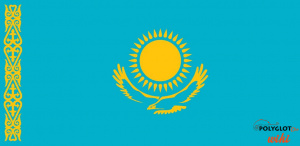Language/Kazakh/Vocabulary/Fruits
Hi Kazakh learners! 😊
In this lesson, we will learn about fruits in Kazakh. Fruits are an essential part of a healthy diet and come in different colors, shapes, and sizes. Along with learning the Kazakh words for each fruit, we will also explore some cultural facts and interesting information related to them. Let's get started!
Don't miss the chance to check out these pages as you wrap up this lesson: Feelings and Emotions & Expressions for Medical Emergencies.
Basic Vocabulary[edit | edit source]
| Kazakh | Pronunciation | English |
|---|---|---|
| алма (alma) | [älˈmä] | Apple |
| банан (banan) | [bɑˈnɑn] | Banana |
| тауық (tauıq) | [tɑwɘq] | Watermelon |
| көктем (köktem) | [kœkˈtem] | Blueberry |
| ананас (ananas) | [anaˈnɑs] | Pineapple |
| алтынай (altınaı) | [ält̪ənäj] | Apricot |
| дыңғалақ (dıŋğalaq) | [də̃ŋˈʁɑlɑq] | Pomegranate |
| ширен (shiren) | [ʃiˈren] | Peach |
| қаймақ (qaymaq) | [qɑjˈmɑq] | Quince |
Cultural Facts and Interesting Information[edit | edit source]
- Apples have been grown in Kazakhstan for thousands of years and are a symbol of the country's agricultural heritage. - Bananas are not native to Kazakhstan but are imported from neighboring countries. - Watermelons are a popular summer fruit and are often enjoyed as a sweet dessert after meals. - Blueberries grow in the mountainous regions of Kazakhstan and are used in various traditional dishes such as the Kazakh dairy product called kurt. - Pineapple is not a commonly consumed fruit in Kazakhstan due to its high price. - Apricots are a popular fruit and are often dried to make the traditional Kazakh snack called chak-chak. - Pomegranates are a symbol of fertility and abundance in many Central Asian countries, including Kazakhstan. - Peaches are widely cultivated in the northern regions of Kazakhstan and ripen in the late summer months. - Quince is used in various dishes and is often made into a sweet preserve called murabba.
Dialogue[edit | edit source]
Person 1: Бұл алма не? (Bul alma ne?) - What is this apple?
Person 2: Бұл алма. Оның өзінде әлсіресе көк сәбізіне тең екен. (Bul alma. Onyń özinde äls̱iresse kök säbïzïne teń eken.) - This is an apple. It is similar to green vegetables.
Person 1: Осы банан пайдасыз болма? (Osy banan paıdasız bolma?) - Is this banana ripe?
Person 2: Жоқ, ол пайдасыз. (Žoq, ol paıdasız.) - No, it is unripe.
Advanced Vocabulary[edit | edit source]
| Kazakh | Pronunciation | English |
|---|---|---|
| дәмдіқ (dämdiq) | [dämˈdɪq] | Grape |
| сарымұқ (sarımıq) | [säɾəmʉq] | Apricot |
| мандарин (mandarin) | [mɑndɑˈrin] | Mandarin |
| мұз (muz) | [mʉz] | Mango |
| алгыз (alğız) | [älˈɢɘz] | Grapefruit |
| шалқам (shalqam) | [ʃälˈqɑm] | Carrot |
| бидай (biday) | [bidɑj] | Raspberry |
| гранат (granat) | [ɡränät] | Pomegranate |
| кәдімгі көктем (kädimgi köktem) | [kædəmˈɢi kœkˈtem] | Huckleberry |
Cultural Facts and Interesting Information[edit | edit source]
- Grapes have been grown in Kazakhstan since ancient times and are used to make traditional Kazakh wines and raisins. - Apricots are a popular fruit in Central Asia and are used in various traditional dishes such as the Uzbek pilaf and the Kazakh soup called shorpo. - Mandarin oranges are a traditional fruit eaten during the Chinese New Year and are also used in traditional Kazakh medicine for their health benefits. - Mangoes are not widely available in Kazakhstan but can be found in larger supermarkets and specialty stores. - Grapefruit is not commonly consumed in Kazakhstan due to its sour taste. - Carrots are an important vegetable in Kazakh cuisine and are often used in the traditional Kazakh dish called beshbarmak. - Raspberries grow in the mountainous regions of Kazakhstan and are used in various traditional Kazakh dishes such as the Kazakh dessert called kymyz. - Pomegranates are a symbol of abundance and wealth in many cultures and are often used in traditional Kazakh medicine for their health benefits. - Huckleberries grow wild in the mountainous regions of Kazakhstan and are used in various traditional dishes such as the Tatar dish called kata.
Dialogue[edit | edit source]
Person 1: Сарымұқ көктемден артық мұқияты бар ма? (Sarımıq köktemden artıq muqiyatı bar ma?) - Are apricots more nutritious than blueberries?
Person 2: Иә, оларда дәмдіқтер мен масаудалық құндылық пайда болады. (Iä, olarda dämdiqter men masaūdalyq q̇undylyq paıda bolady.) - Yes, they contain more grapes which are beneficial for health and beauty.
Person 1: Бұл мандарин емес, шынымен бұл бидайдың шегі. (Bul mandarin emes, şynymen bul bidaydyń şegi.) - This is not a mandarin, it is actually the seed of this raspberry.
Person 2: Айта көрмесек, осы бұлғарғандық. Қатты жүректіңді ұнатар еді. (Aıta körmeseq, osy bulğarğandyq. Qat'ty jürektińdi unatar edi.) - Let me tell you, this is a Bulgarian fruit. It would have pleased your heart very much.
Sources[edit | edit source]
- Kazakh Vocabulary - Fruits
- My First 100 Basic Kazakh English Words for Kids: An amazing ...
- 20 FREE Fruits Flashcards in 4 PDF formats | Kazakh(latin) Pictures
➡ If you have any questions, please ask them in the comments section below.
➡ Feel free to edit this wiki page if you think it can be improved. 😎
Other Lessons[edit | edit source]
- Education
- Colors
- Count to 10
- Health
- Days of the Week
- Drinks
- How to Say Hello and Greetings
- Idiomatic Expressions
- Food
- Feelings and Emotions

